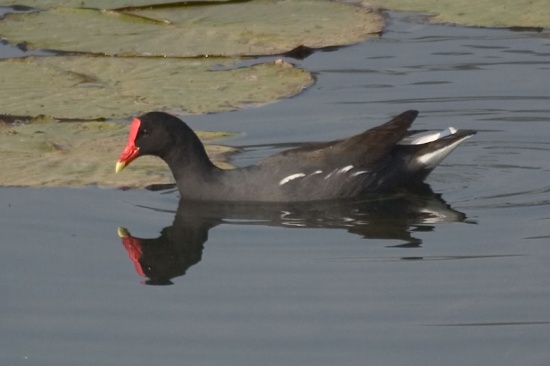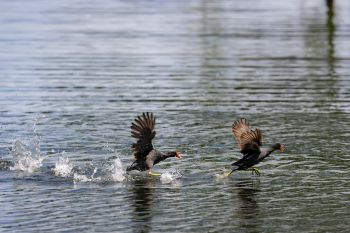- Gallinula galeata
Identification
Length 30-36 cm (11¾-14¼ in); weight 230-340 g (males larger than females).
Adult: Slaty black, except for a white under-tail and white streaks on the flanks. Eye red; bill red with a greenish-yellow tip; frontal shield red, with a truncated or even slightly bilobed apex; legs and feet yellowish green with a red garter above the tarsal joint.
Immature: Above dark brown; below buffy, paler in centre of belly; iris grayish brown; bill and frontal shield greenish brown; legs and feet greenish, garter yellow.
Chick: Downy black; feathers around neck tipped white; skin above eye blue; bill red, tip yellow; small frontal shield red; legs and feet blackish brown.
Similar species
Common Moorhen (which see), recently found as a vagrant in Alaska and suspected in easternmost Canada, is very similar.
Distribution
From southern Canada south to Central and South America, on the Hawaiian Islands and Galapagos Islands.
Taxonomy
Formerly treated conspecific with Common Moorhen.
Subspecies
There are 7 subspecies1:
- G. g. sandvicensis - Hawaiian Islands
- G. g. cachinnans - South-eastern Canada to western Panama, Bermuda and Galapagos Islands
- G. g. cerceris - Greater and Lesser Antilles
- G. g. barbadensis - Barbados
- G. g. pauxilla - Eastern Panama to northern and western Colombia, arid western Ecuador and north-western Peru
- G. g. garmani - Andes of Peru to Chile, Bolivia and north-western Argentina
- G. g. galeata - Guianas to northern Argentina, Uruguay and Brazil; Trinidad
Habitat
Virtually any kind of freshwater: marshlands and swamps, lakeshores and riverbanks, often in urban parks and sewage ponds. Frequently feeds on grass adjacent to water.
Behaviour
Actions
Runs across the water before take-off. Legs trail behind. Swims with a jerky head movement. Often seen swimming and feeding while doing so, but also feeds during excursions up on e.g., lawns.
Diet
Omnivorous. Grazes on land and dives, or dabbles, for vegetable matter, small crustaceans and insects.
Breeding
Occurs in all months of the year; may rear up to 8 broods/year. The nest is a bowl of rushes and reeds concealed in dense aquatic vegetation well above the water level; built by both sexes. Clutch: 4-9 eggs (sometimes up to 11, possibly laid by 2 females). Eggs: Dark buff to grayish white, spotted, freckled and blotched with red-brown and slate; weigh about 25 g. Incubation: 21-22 days by both sexes; the female incubates only by day and the male incubates at night. Fledging: 40-50 days; young dependent on parents for 1-6 weeks after first flight.
Vocalisation
Primary call is a is a rich nasal “laughter” not heard from similar Common Moorhen. Also a wide variety of clucking and chattering calls, sometimes repeated for long periods.
Movements
In North America most of eastern population migratory, moving to winter quarters along coast and south to Panama, West Indies and possibly South America. Some seasonal altitudinal migration in western population and seasonal movements in South America. Hawaiian population resident.
References
- Clements, J. F., T. S. Schulenberg, M. J. Iliff, S. M. Billerman, T. A. Fredericks, B. L. Sullivan, and C. L. Wood. 2019. The eBird/Clements Checklist of Birds of the World: v2019. Downloaded from http://www.birds.cornell.edu/clementschecklist/download/
- Avibase
- SACC proposal to split Common Gallinule from Common Moorhen
- Bannor, B. K. and E. Kiviat (2002). Common Gallinule (Gallinula galeata), version 2.0. In The Birds of North America (A. F. Poole and F. B. Gill, Editors). Cornell Lab of Ornithology, Ithaca, NY, USA. https://doi.org/10.2173/bna.685
- del Hoyo, J., Collar, N., Christie, D.A. & Kirwan, G.M. (2020). Common Gallinule (Gallinula galeata). In: del Hoyo, J., Elliott, A., Sargatal, J., Christie, D.A. & de Juana, E. (eds.). Handbook of the Birds of the World Alive. Lynx Edicions, Barcelona. (retrieved from https://www.hbw.com/node/467254 on 26 January 2020).
- Pyle, R.L., and P. Pyle. 2017. The Birds of the Hawaiian Islands: Occurrence, History, Distribution, and Status. B.P. Bishop Museum, Honolulu, HI, U.S.A. Version 2 (1 January 2017) http://hbs.bishopmuseum.org/birds/rlp-monograph/
Recommended Citation
- BirdForum Opus contributors. (2024) Common Gallinule. In: BirdForum, the forum for wild birds and birding. Retrieved 26 April 2024 from https://www.birdforum.net/opus/Common_Gallinule
External Links
GSearch checked for 2020 platform.1







